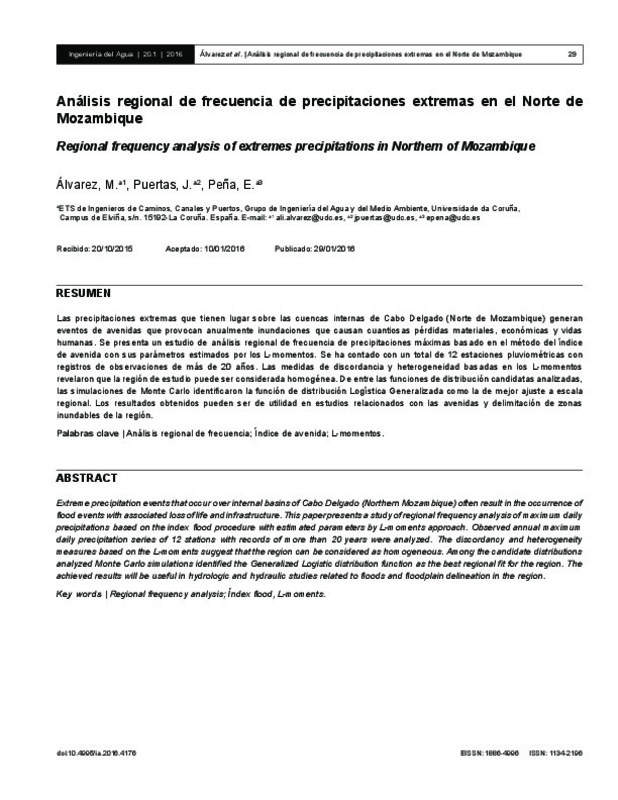Chiew, F.H., Siriwardena, L. (2005). Trend/Change detection software. USER GUIDE. CRC for Catchment Hydrology, Australia.
Dalrymple, T. (1960). Flood frequency analysis. USGS Water Supply Paper 1543-A.
Fisz, M. (1963). Probability Theory and Mathematical Statistics. John Wiley, New York.
[+]
Chiew, F.H., Siriwardena, L. (2005). Trend/Change detection software. USER GUIDE. CRC for Catchment Hydrology, Australia.
Dalrymple, T. (1960). Flood frequency analysis. USGS Water Supply Paper 1543-A.
Fisz, M. (1963). Probability Theory and Mathematical Statistics. John Wiley, New York.
Grayson, R.B., Argent R.M., Nathan, R.J., McMahon, T.A., Mein, R. (1996). Hydrological Recipes: Estimation Techniques in Australian
Hydrology. Cooperative Research Centre for Catchment Hydrology, Australia.
Greenwood, J.A., Landwehr, J.M., Matalas, N.C., Wallis, J.R. (1979). Probability weighted moments: definition and relation to parameters of several distributions expressible in inverse form. Water Resources Research, 15(5), 1049-1054. doi:10.1029/WR015i005p01049
Gumbel, E.J. (1958). Statistics of extremes. Columbia University Press, New York.
Guttman, N.B. (1993). The use of L-moments in the determination of regional precipitation climates. Journal of Climate, 6, 2309-2325. doi:10.1175/1520-0442(1993)006<2309:TUOLMI>2.0.CO;2
Guttman, N. B., Hosking, J. R., Wallis, J. R. (1997). Regional precipitation quantile values for the continental U.S. computed from L-moments. Journal of Climate, 6, 2326-2340. doi:10.1175/1520-0442(1993)006<2326:RPQVFT>2.0.CO;2
Hirsch, R.M., Slack, J.R., Smith, R.A. (1982). Techniques of trend analysis for monthly water quality data. Water Resources. Research, 18(1), 107-121. doi:10.1029/WR018i001p00107
Hosking, J. R. (1986). The theory of probability weighted moments. Research Report RC 12210, IBM Research Division. Yorktown Heights, NY.
Hosking, J.R. (1988). The four-parameter kappa distribution. Research Report RC 13412, IBM Research Division, Yorktown Heights, NY.
Hosking, J. R. (1990). L-moments: Analysis and Estimation of Distributions using Linear Combinations of order Statistics. Journal of Royal Statistical Society, 52(1), 105-124.
Hosking, J.R. (1994). The four-parameter kappa distribution. IBM Journal of Research and Development,38(3), 251-258. doi:10.1147/rd.383.0251
Hosking, J.R., Wallis, J.R. (1997). Regional frequency analysis: an approach based on L-moments. Cambridge University Press. doi:10.1017/cbo9780511529443
Hosking, J.R. (2014a). Regional frequency analysis using L-moments. R package: lmomRFA, versión 3.0: July, 2, 2014. (http://cran.r-project.org/web/packages/lmomRFA/index.html).
Hosking, J.R. (2014b). L-moments. R package: lmom, versión 2.4: July, 2, 2014. (http://cran.r-project.org/web/packages/lmom/index.html)
Jenkinson, A.F. (1955). The Frequency Distribution of the Annual Maximum (or Minimum) Values of Meteorological Elements. Quaterly Journal of the Royal Meteorological Society, 87, 158. doi:10.1002/qj.49708134804
Jenkins, G.M., Watts, D.G. (1968). Spectral analysis and its applications. Holden-Day, San Francisco, California.
Kendall, M.G. (1975). Rank Correlation Methods. 4th Edn., Charles Griffin, London.
Kundzewicz, Z.W., Robson, A. (2000). Detecting Trend and Other Changes in Hydrological Data. World Climate Program - Water, WMO/UNESCO, WCDMP-45, WMO/TD 1013, Geneva.
Madsen, H., Pearson, C.P., Rosbjerg, D. (1997). Comparison of annual maximum series and partial duration series methods for modeling extreme hydrologic events 2. Regional modeling. Water Resources Research, 33(4), 759-769. doi:10.1029/96WR03849
Mann, H.B. (1945). Non-parametric test against trend. Econometrica, 13(3), 245-259. doi:10.2307/1907187
Meacham, I. (1968). Correlation in sequential data three sample indicators. Civil Eng. Trans. Inst. Eng. Aust., 10, 225-228
Norbiato, D., Borga, M., Sangati, M., Zanon, F. (2007). Regional frequency analysis of extreme precipitation in the eastern Italian Alps and the August 29, 2003 flash flood. Journal of Hydrology, 345(3-4), 149-166. doi:10.1016/j.jhydrol.2007.07.009
Ngongondo, C.N., Chong-Yu, X., Lena, M.T., Berhanu, A., Tobias, C. (2011). Regional frequency analysis of rainfall extremes in Southern Malawi using the index rainfall and L-moments approaches. Stochastic Environmental Research and Risk Assessment, 25(7), 939-955. doi:10.1007/s00477-011-0480-x
Organización Meteorológica Mundial, (1994). Guía de prácticas hidrológicas. Quinta edición, OMM-Nº 168, Ginebra.
Parida, B.P., Moalafhi, D.B. (2008) Regional rainfall frequency analysis for Botswana using L-Moments and radial basis function network. Physics and Chemistry of the Earth, 33(8-13), 614-620. doi:10.1016/j.pce.2008.06.011
Pearson, C.P., McKerchar, A.I., Woods, R.A. (1991). Regional flood frequency análisis of western Australian data using L-moments. International Hydrology and Water Resources Symposium, Perth, Australia, 631-632.
Siegel S., Castellan N.J. (1988). Non-parametric Statistics for the Behavioural Sciences. McGraw-Hill, New York, USA.
Smithers, J.C., Schulze, R.E. (2001). A methodology for the estimation of short duration design storms in South Africa using a regional approach based on L-moments. Journal of Hydrology, 241(1-2), 41-52. doi:10.1016/S0022-1694(00)00374-7
Student, (1908). The probable error of a mean. Biometrika,6(1), 1-25. doi:10.1093/biomet/6.1.1
Vogel, R.M., Fennessey, N.M., 1993. L-moment diagrams should replace product moment diagrams. Water Resources Research,29(6), 1745-1754). doi:10.1029/93WR00341
Vogel, R.M., Thomas, W.O., McMahon, T.A. (1993). Flood-flow frequency model selection in southwestern United States. Journal of Water Resources Planning and Management, 119(3), 353-366. doi:10.1061/(ASCE)0733-9496(1993)119:3(353)
[-]








